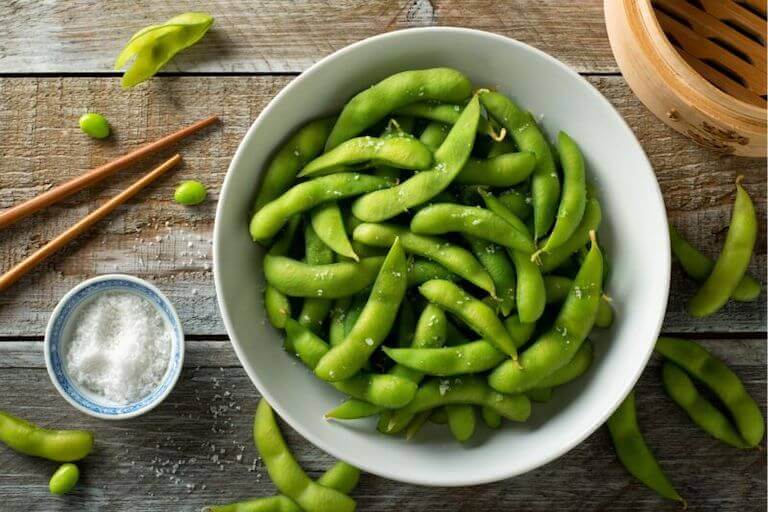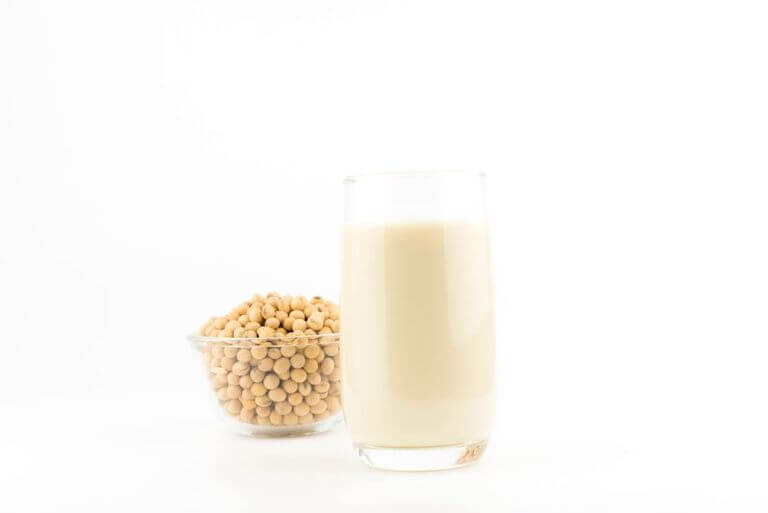Listen to This Article:
In recent decades, soy products have become a dietary staple for vegetarians and healthy eaters around the world. Today, soy foods like tofu, soy milk, and tempeh have become much more common as meat and dairy substitutes, or just for fun. However, some researchers and consumers have worried that soy may not be as healthy as it initially seemed. So, are soy foods good for you? Should you use them in place of animal protein and milk?
Health research seems to confirm that soy-based foods have a number of health benefits. In this article, we’ll explore the pros and cons of eating soy.
What Are Soy Foods?
“Soy foods” refers to foods made from soybeans (Glycine max), an annual leguminous plant.

Soybeans make up 31% of the agricultural crops in the United States.
Until the 1970s, soy foods were primarily a feature of Asian cuisine in the US. But interest in plant-based diets, fueled by books like Diet for a Small Planet by Francis Lappé Moore and the emerging counterculture of the 1960s and 1970s, popularized soy as an environmental and health-conscious food.
Today, soy is one of the most commonly grown agricultural crops in the world, produced for its edible bean as a food source for both people and livestock. Thirty-one percent of US farmland is planted in soybeans annually, making it the second most common crop after corn.
People most often eat soy foods in the form of tofu, soy milk, soy sauce, and edamame, the Japanese appetizer made from whole soybeans served in the pod with coarse salt.
Two Types of Soy Foods
| Minimally Processed Soy Foods | Processed Soy Foods |
|---|---|
| Tofu | Store-bought soy milk |
| Miso | Soybean oil |
| Whole soybeans (edamame) | Soy sauce |
| Tempeh | Soy protein and lecithin |
Pros of Eating Soy
In its whole food forms, soy can be a delicious, healthy addition to your regular diet. Not only is soy a nutritious animal-protein replacer for people who eat a plant-based diet, but it’s also been shown to have a variety of other positive health benefits.

Agedashi tofu, a breaded and fried tofu served in a savory soy-based broth, is a favorite appetizer in Japanese cuisine.
Soy Helps Feed Your Body
As a simple, whole, plant-based food, soy is solid nutrition. For a plant-based food, soybeans are high in protein: one cup of soybeans contains 31 grams of protein. And unlike many other plant-based protein sources, which have lower-than-needed amounts of certain amino acids, soy contains all nine of the essential amino acids in ample amounts.
Soy foods are also relatively high in calcium and have moderate amounts of magnesium, iron, phosphorus, and zinc. They are also high in folate (vitamin B9) and thiamine (vitamin B1).
Soy Has a Beneficial Effect on Hormones
Most people who are concerned about soy’s health impacts have heard that it might affect hormones.
Soy contains two isoflavones, plant compounds similar to one type of human estrogen. Some people have theorized that these “phytoestrogens” could increase the risk of estrogen-related cancers (like breast cancer), affect thyroid hormone levels, or have a negative effect on male reproductive health.

Soy sauce, a fermented, salty condiment, is a common way soy finds its way into the American diet.
Research studies suggest that ordinary soy in your diet does not have these impacts. In fact, soy isoflavones have been shown to reduce the risk of breast cancer for pre- and post-menopausal women and may also help prevent or improve menopause symptoms.
Soy isoflavones were also shown not to have an impact on men’s reproductive health. Instead, several studies have demonstrated that eating more soy is associated with a reduced risk for prostate cancer in men.
And when it comes to soy’s effect on the thyroid gland, a recent meta-analysis found that there is no evidence that consuming soy affected thyroid hormone levels.
Soy is Likely Good for Your Heart Health
Cardiovascular disease is the most common cause of death in the US and is associated with high blood pressure, high cholesterol, diabetes, and obesity. Diet can be an important way to improve your heart health. Dietary soy protein has been shown in multiple studies and meta-analyses to help reduce LDL cholesterol levels, albeit by a relatively small amount.
Soy also contains omega-3 fatty acids, which may improve cardiovascular outcomes.
Soy Isoflavones May Improve Bone Health
Osteoporosis, or bone density loss, is common as people age, especially in post-menopausal women. This is because estrogen helps maintain bone density. As women go through menopause and their estrogen levels go down, they begin to lose bone density.
The estrogenic soy isoflavones in supplement form have been shown to help maintain bone density and prevent osteoporosis. This suggests that soy may be a healthy food for aging women in particular.
Soy Foods Taste Good
One of the biggest benefits of eating soy foods is that they taste good! Japanese and Chinese cuisine offer dishes like agedashi tofu, teriyaki sauce, natto, edamame (salted and steamed whole soybeans), and stir fries that feature soy foods.
Soy sauce, miso, and tamari famously provide that elusive fifth flavor, umami, to dishes in all kinds of cuisine. And the plant-based community has popularized flavorful soy favorites such as baked tofu, glazed tempeh, and soy nuts as meat replacements.
Cons of Eating Soy Foods
With all these benefits, what’s not to love about soy foods? Though soy may be nutritious and have documented health benefits, as with any food, it may not be right for everyone. Here are a few of the cons of eating soy foods.
Soy Allergy or Intolerance
In 2022, it was estimated that 1.9 million people in the US in 2022 were allergic to soy. Soy is one of the top six food allergens, along with gluten, dairy, nuts, eggs, and shellfish.
As with most allergies, reactions can include itching, sneezing, gut irritation and upset, and in the worst cases, anaphylaxis. Soy additives, like soy lecithin, soy oil, or soy protein isolate are common in processed foods, which can make it difficult for people with a true soy allergy to avoid exposure.
And allergies may not be the only food reaction you can get from soybeans. As with many beans, some people will experience gas from eating soy foods like edamame or tofu. This is likely due to the high level of fermentable carbohydrates in soybeans.
Soy, GMOs, and Herbicides
Despite soy’s healthy nutrition profile, the vast majority of soy farmers in the US and Europe use soybean seed that has been genetically modified to be herbicide-tolerant. As of 2024, 96% of the soy grown in the US is GMO. Most of this is likely soy that has been bred to tolerate spraying with the herbicide glyphosate.

Soybeans are one of the most common agricultural crops in the US. Almost 96% of US soy is genetically modified to be herbicide-resistant.
This means that most soy products that are not grown organically may have glyphosate residue. Glyphosate is a suspected carcinogen and has been associated with non-Hodgkins lymphoma and myeloma.
A more low-level, but no less impactful problem is the potential impact of glyphosate exposure on the gut microbiome. Research suggests that even small exposures can negatively affect your gut bacteria.
All this means that eating soy frequently may expose you to herbicide residue and the associated health problems. However, as with all low-level exposures to agricultural chemicals, proving the association is challenging. There are a wide variety of studies suggesting that glyphosate exposure can cause health impacts. But are there studies specifically linking soy food consumption to an increased risk of health problems caused by glyphosate exposure? The short answer is no. For now, glyphosate has been deemed safe when used as directed, and it’s up to each consumer to make their own choice.
How Do I Even Prepare Soy Foods?
Though soy foods like tofu are more common than they were 30 years ago, many people still don’t know how to prepare them. If you don’t know what to do with them, it’s easy for them to turn out bland and flavorless, or with a less-than-desirable texture. This can be a downside for working with soy foods.
The good news is, with a few simple hacks, foods like tofu can be dressed up to be delicious.
5 Ways to Make Tofu Taste Good!
Detractors are quick to point out that tofu either doesn’t taste good or doesn’t taste like much at all. Here are five tips to make tofu tasty!
- Buy the right consistency tofu for the job, and if you’re new to tofu, stick with firm or extra firm.
- Sauté it low and slow in a non-stick pan. Longer cook times create crispier edges.
- Season appropriately. Tofu loves turmeric, cumin, berbere seasoning, and other bold spices.
- Marinate if serving raw. Plain tofu can be bland in salads; soak it in oil, vinegar, salt, and spices first.
- Slice thin and bake. Baking helps dehydrate the tofu and create a better texture.
Balancing the Pros and Cons
So should you eat soy or not? The answer largely depends on a variety of factors. Of course, if you’re worried about the potential health impacts of eating soy, don’t eat it. If you would like to include soy in your diet but are concerned about some of the potential downsides, here are some tips.
Eat More Whole-Food Forms of Soy Foods
Probably the most important factor is which types of soy products you eat. In general, when eaten in moderation, minimally processed soy foods, like tofu, tempeh, tamari, and whole soybeans, like edamame, are healthy plant-based protein sources that help reduce cholesterol, reduce breast cancer risk and menopause symptoms, and help prevent osteoporosis. More highly processed soy derivatives may be less healthy.

Soy milk and soy nuts (toasted and dried soybeans) are two other ways to add soy to your diet.
Avoid Soy Foods If You Show a Sensitivity or Allergy
As with any food, soy may not be right for everyone. It may not be appropriate for someone with sensitivity to beans, or a soy allergy. If you seem to not feel well every time you eat soy products, it may be best to avoid them. If you’re not sure if you have a soy allergy or sensitivity, reach out to your healthcare provider.
Eat Organic Soy Products
If you’re concerned about the environmental and health impacts of GMOs and herbicide-resistant soy, the simplest path is to choose organically grown soy products. Organic certification rules forbid the use of GMOs and herbicides like glyphosate. This way, you can enjoy the nutritional and health benefits of soy, but avoid the potential problems of herbicide contamination.
Find Your Expertise With Plant-Based Culinary School
Soy foods are a centerpiece of plant-based diets, and preparing them skillfully is essential to wowing your clients and customers. At Auguste Escoffier School of Culinary Arts, we offer a Plant-Based Culinary Arts diploma program that can provide what you may need to start a career in plant-based food service.
We cover topics ranging from plant-based menu design and business planning to including a farm-to-table ethic in your cooking. Explore your options for getting started with a plant-based education by learning more about our diploma and degree programs.
IF YOU LIKED READING ABOUT THE PROS AND CONS OF EATING SOY, CONSIDER READING THESE ARTICLES NEXT:
- Why Chefs Should Care About Culinary Nutrition
- What Credentials Do You Need to Be a Plant-Based Chef?
- How Plant-Based Meat Substitutes Are Changing the Way We Eat
* This article was originally published on May 17, 2014, and has since been updated.

